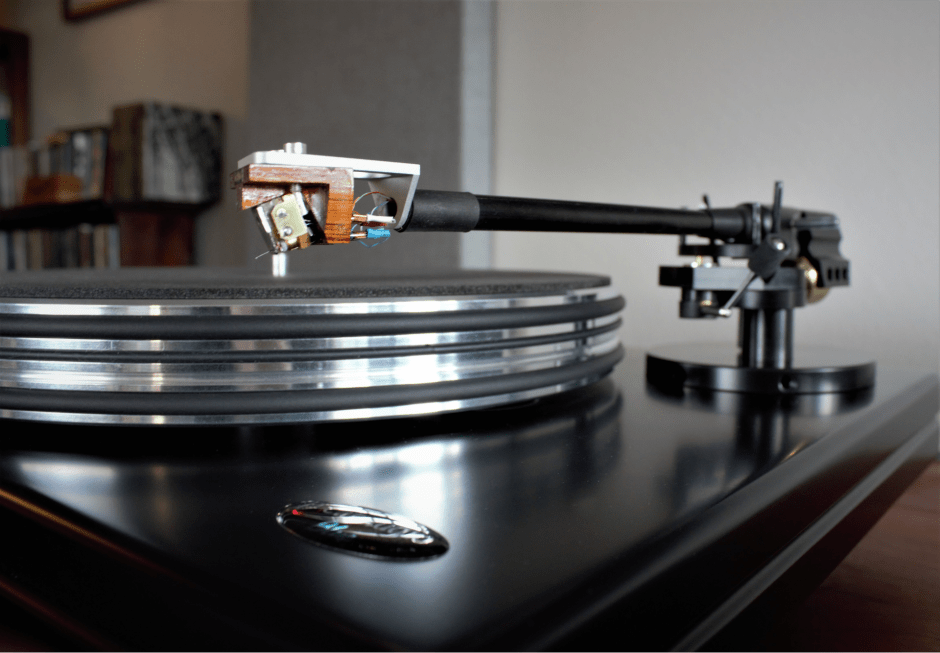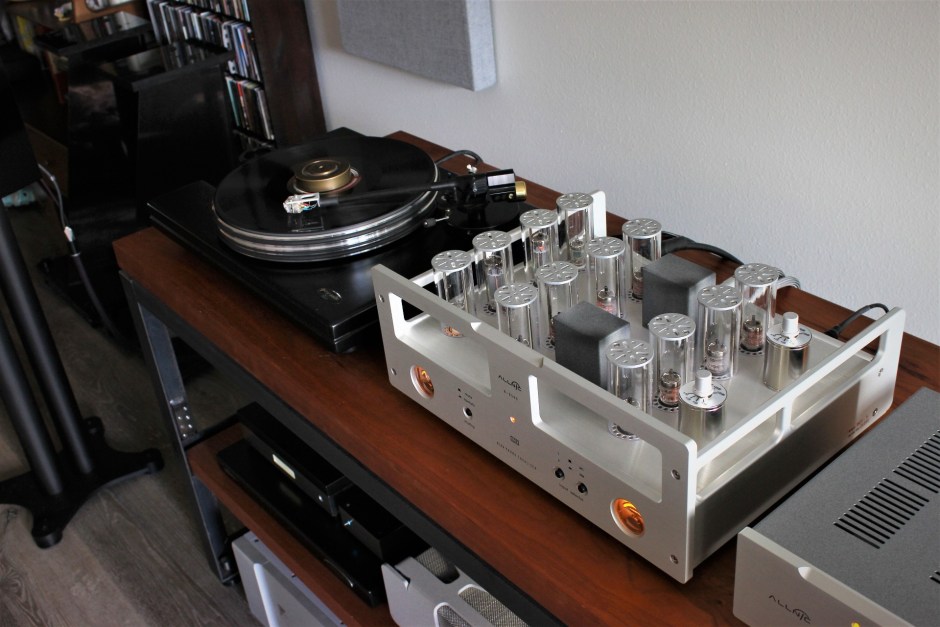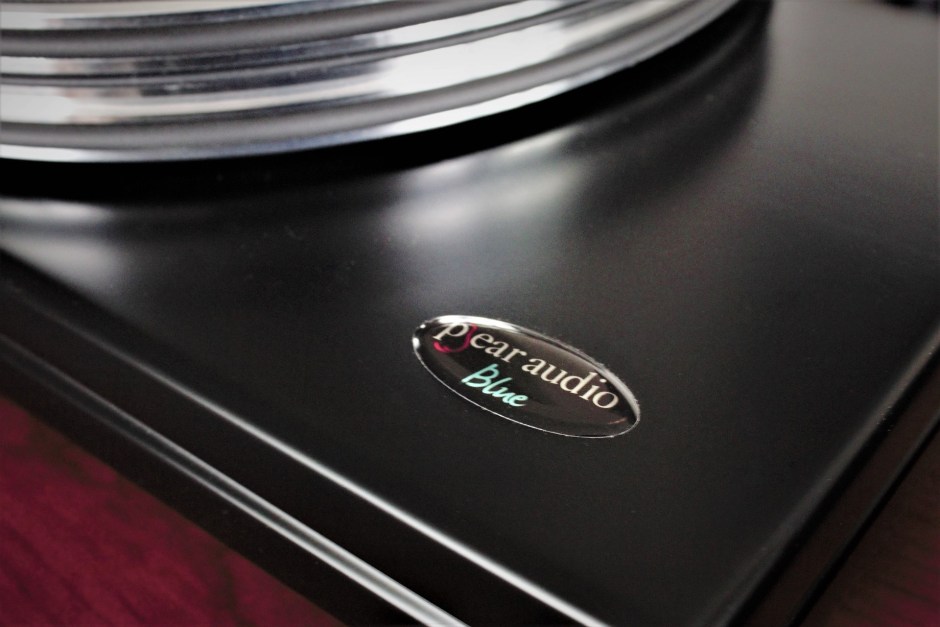I needed a workhorse turntable. It took me over two years to decide on one, but I finally settled on the Pear Audio Blue Kid Howard turntable, complete with the Pear Audio Blue Cornet 2 tonearm. Why the Pear Audio Blue? It’s a strange and convoluted tale, but here goes.
As I’ve mentioned repeatedly, I used that Technics SL-1200G, borrowed from PTA publisher Scot Hull for the first three years I’ve been here. For a while, I thought I’d never have to give it back. I got used to the idea of spending the rest of my life with it. I even bought a couple of removable headshells, another audiophile rabbit hole for Technics owners. But then one day Scot called and said, “I need it back.”
Words and Photos by Marc Phillips
What the 1200G had become was a workhorse, something I could use as a back-up turntable when I didn’t have something in for review. I needed my workhorse turntable to be simple, easy to set-up, and incredibly reliable. While I still wanted to play with fancy, esoteric turntables, I needed something that would play vinyl anytime I asked, no questions asked.
I immediately thought about another SL-1200G, or an SL-1210G. Due to all those supply chain issues out there, the waiting list for a new G kept getting longer and longer, and I needed something now. Okay, I told myself. Can there be anything more exciting, at least to a guy who calls himself The Vinyl Anachronist, than to buy a new turntable—anything I wanted, at least within a budget?
The usual suspects came and went—the Rega P10 I’ve always wanted, maybe a rebuilt Thorens TD-125 II, maybe the Gem Dandy Polytable I enjoyed so much a couple of years ago. It got to the point where every day I would wake up with a different turntable on my mind, but for one reason after another I had to move on. Much of the time it was those dang supply chain issues. In more than one case, I simply couldn’t get someone on the phone. My kingdom for a turntable, indeed.
I do want to bring up my budget for a second, because that dictated my choices. If money wasn’t an issue, I’d just contact Hans van Vliet in Amsterdam and purchase one of his meticulously restored EMT 927s—for around the price of a new BMW M3. (Why do I always pick on the BMW M3 for these high-end audio price comparisons? Frankly, I have no idea.) Maybe that EMT is strictly an old man toy, something to look forward to when I’m a hermit. For now, I needed something that was a) reliable and b) sounded great and c) was roughly the same price as a new Technics SL-1200G.
One person stepped forward and said “Hi, Marc. I have a great turntable for you. I can send it to you right now.” That was Michael Vamos of Audio Skies, the North American distributor for Pear Audio Blue. I know all about Pear Audio Blue, of course—Scot Hull reviewed the Pear Audio Blue Kid Thomas just a couple of years ago. I also know the story behind Pear Audio Blue, that it’s the reincarnation, of sorts, of Nottingham Analogue—a turntable brand I always admired. These are the core designs from the late Tom Fletcher, which were given to Pear Audio’s Peter Mezek. (The original company still exists, however.)
So I ended Turntable Madness 2022 and told Michael that I’d review the Pear Audio Blue Kid Howard—a turntable fitted with the company’s flagship Cornet 2 tonearm for $5,000, just a bit more than the Technics. (Michael sent me a Kid Howard with the optional black satin finish, which bumps the cost to $5,500 for the complete rig.)
If I loved it, I told Michael, I would buy it.
Inside the Pear Audio Blue Kid Howard
If you’re familiar with the Nottingham Analogue turntables of yore, you’ll know that Tom Fletcher, preferred to use low torque motors that were just powerful enough to keep the platter spinning at the right speed, and no more. The idea, of course, is that the bigger the motor, the more vibrations and noise it creates. What this means, ultimately, is that you have to give the platter a spin with your hand in order to get it up and running.
I ran into this type of design when I reviewed the Palmer 2.5t turntable a couple of years ago, another design that was inspired by Fletcher’s turntables. The Palmer has a very big and heavy platter, so the low-torque motor has to work harder. But I also discovered that you don’t need a push to get the platter going at 33rpm—it takes a minute or two, but it gets there on its own. At 45 rpm, however, the platter just sits there, motionless, until you put your back into it.
The Pear Audio Blue Kid Howard, however, does nothing without your help. I wound up being fascinated by this type of operation and came up with practical jokes to play on vinyl newbies. Hey, check out this turntable—there’s no electricity, no motors, just flawless bearings that will allow the platter to spin forever if you let it! Those last few words would be accompanied by me, reaching out and dramatically stopping the platter of this perpetual motion contraption by hand.
That’s right, you start and stop the Pear Audio Blue Kid Howard with your hand. There are no power or on/off switches anywhere—if the Kid Howard is plugged into an outlet, it is running. If you place your finger on top of the motor housing, you will feel a vibration, but it is contained through a series of isolation tactics. You won’t feel a vibration anywhere else but on that motor.
This simple departure from the norm is what gives the Pear Audio Blue Kid Howard its considerable personality and charm. I was looking for simple, practical and reliable, and that’s what I got. But I also got a lot of personality and charm, and it suits me just fine. Spinning records shouldn’t be a bore.
Inside the Cornet 2 Tonearm
The Pear Audio Blue Cornet 2 tonearm, which costs $2,495 on its own, is a 10″ long unipivot arm that contains just as many unusual design touches as the Kid Howard. The Cornet 2, as explained on the Pear Audio Analogue website, explains it thusly:
“Unipivot arms are usually designed with the pivot sitting in a silicone bath. The problem with this design is that the silicone bath takes quite a while to settle down, so the sound of the arm changes as it plays. Many unipivots uses eccentric counter weights to insure proper azimuth.
“Cornet’s unipivot design uses a new approach: to maintain azimuth, along with a special material, developed with viscosity properties that do not flow and do not require “settling time.” A hi-tech carbon fibre tube with fibres along the length, not wrapped around the arm, greatly increases the strength, resonance control and rigidity of the arm.
Cornet arms also have an unusual new headshell design. Meticulous attention to the material went into the development, producing an arm more sonically in phase. The headshell also has no finger lift. These features ensure that the arm is properly balanced and no uncontrolled resonances run around the headshell.”
Michael Vamos had this to add:
“The tonearm is technically a unipivot, but unlike most unipivots which can rotate freely in all directions, the Cornet 2 arm is limited in the horizontal plane by two parallel bars around a bearing that only allows for tiny horizontal movement, just enough to be able to adjust to any changes in the groves. So unlike a traditional unipivot, the Cornet 2 arm is much more stable and tracks better than traditional unipivots.“Also worth mentioning that unlike other tonearms, the anti-skating is different as the cartridge moves across the surface from outer to inner groves, so if the tonearm does not counter this change in, it will only be correct at one point on the surface. Once you have set the anti-skating correct on the Cornet 2 arm, it is correct across the ENTIRE playing area, thanks to another proprietary design where the unique two levels that changes as the cartridge moves across the record surface. Other tonearms the anti-skating is only correct at the point of the record surface where you set the anti-skating.”
The Cornet 2 is beautifully finished, and downright graceful in appearance with its smooth lines and streamlined profile–especially toward the pivot. The headshell also radiates with excellent build quality, although I did find that it was thick enough to require longer mounting screws for the cartridge than usual. (That just means I had to reach into my huge Grab Bag of Mounting Hardware, with half of the contents spilling onto the carpet.)
Pear Audio Blue Kid Howard Set-Up
Set-up for the Pear Audio Blue Kid Howard turntable and the Cornet 2 tonearm is simple and straightforward. The plinth is unusually light on the Kid Howard, but the platter is surprisingly heavy. All the pieces fit together in the usual ways, and you’ll probably have it together before you even think of checking the owners manual. That’s what I did, and when I reviewed my work in the manual I found I had gotten it mostly right.
The motor assembly slides neatly in the rounded notch on the side of the plinth, and you ensure that the motor isn’t coming in contact with the rest of the turntable–except for the belt, of course. I was curious about that low-torque motor, and how I could feel it vibrating on the top. That has to be transmitted through the belt, I thought, and I was right. Then I noticed two additional rubber rings in the box, which at first looked like additional belts except they were much thicker. I glanced at the side of the platter, noticed the two extra ridges bookending the drive belt and figgered it all out on my own. Once installed, these two rings seemed to completely remove the vibrations coming from the motor. It’s a nifty mechanical solution.
Another unusual little feature on the Pear Audio Blue Kid Howard turntable is a short length of rubber hose that runs through a hole in the plinth underneath the platter, where you don’t see it unless you’re looking at the turntable at eye level. When I first noticed it, all I could think of was the little drain tubes in record cleaning machines, the ones designed to empty the excess cleaning fluid all over your floor. (At least it does at my house.)
It turns out that the tube has nothing to do with fluids–it’s a nifty rubber brake that helps you to stop the turntable manually. One end touches the underside of the platter, the other touches the shelf underneath the ‘table. It made sense to me, especially when I remembered how difficult it was to stop the Palmer turntable when it was running at 45rpm.
As Michael Vamos explained to me:
“The piece of rubber at the bottom of the platter is another proprietary, simple and unique design by Pear Audio Blue that applies and tiny amount of resistance to the platter. As you mentioned, the platter will continue spinning and spinning even without the motor running, once you spin it. This tiny amount of resistance results in the motor pulling the motor at a more consistent speed. Very simple, but very effective.“Example: If you try to pull a rope with no weight at the end, you will pull hard and soft and with various force, but if you put a little bit of resistance at the end of the rope, it becomes much easier to pull with a consistent force. We call it the speed enhancer.”
The Cornet 2 tonearm was easy to install–a BIG plus since I often find high-end tonearms to be fiddly when it comes to the initial set-up, with occasionally daunting learning curves. I did miss the Technics SL-1200G’s precise VTA wheel at the base of the arm–the Kid Howard’s VTA adjustment involved a back-and-forth battle between the entire tonearm assembly moving up and down the hole in the armboard, and adjusting the VTA screw on the cuing platform. Not difficult, but it did take me a little bit longer than usual to get it perfect the first time.
I also found the counterweight unusual–it’s a solid hunk of brass that slides in and out of the undercarriage of the main tonearm assembly. It’s not quite as precise as something that has dials and numbers and markings, but I found I could make minute adjustments to the tracking force through soft taps on the back or front of the weight.
Since I’ve been using the Pear Audio Blue Kid Howard for the last several months, a lot of systems have come and gone. Phono stages include the Allnic Audio H-6500, The Grail from Van den Hul, the inboard phono section of the Bel Canto Design e1X integrated amplifier and my own Pureaudio Vinyl. Cartridges included the Koetsu Urushi Black with and without the Koetsu SUT, the ZYX Ultimate Airy X and Bloom 3, and the Van den Hul Crimson XGW Stradivarius.
One final thing about the Pear Audio Blue Kid Howard–it comes with a lightweight foam mat. I had nothing against it, other than the fact that it seemed to get dirty quite easily and that kept showing up on the photos. I realized that I still have an old Funk Firm Acromat, which always made a difference for me on Rega turntables, and the new platter mat from Les Davis Audio. So I swapped and I listened and I compared and I’ll probably have more to say when I review the LDA accessories in the near future. For this review, I’ll confine my comments to the stock mat.
Kid Howard Sound
A long time ago I knew a dealer who sold both Regas and Nottinghams, side by side. He liked both ‘tables a lot, but he once told me that if you’ve been listening to Regas, the Nottinghams might sound a little slow and dull. If you’re listening to Nottinghams, however, the Rega will sound too juiced up and artificial. “The Nottingham might sound a little dull,” he said. “But it’s actually far more neutral.”
Not once did I think of the Pear Audio Blue Kid Howard as sounding slow or dull. The rig, once finely tuned, did sound neutral to my ears. If anything, the Pear Audio rig sounded laid back and relaxed, which is a good thing in the world of analog. We’re talking about a soundstage that seems larger and deeper than you’d expect from this price point, the Kid Howard is just on the edge of the plain where the wild high-mass ‘tables roam, with their stable imaging and powerful bass.
Maybe, if compared to a Rega, the Kid Howard might seem to offer a seat that’s a few rows further back from the stage. But a lot is always happening behind the front baffles, and off to the sides–sometimes way out. That means everything sounds bigger and more open, including the space between you and the performers. The flip side, of course, is that the Pear Audio Blue sound will never be described as forward or too in-you-face or aggressive. It spreads out into the room, and settles in for the long haul.
The sheer tonality of the Pear Audio Blue Kid Howard is what finally convinced me of its true worth. With the Koetsu and the ZYX Ultimate, this turntable is ideal for audiophiles who are always waiting to hear something that sounds utterly real, something that makes you jump up in your seat, something that makes you want to hear again just to make sure it was THAT real. I don’t always hear those moments of pure astonishment from a turntable/arm combo this affordable, Shelly Manne’s ride cymbal on Way Out West, some of the dogs barking way off to the right on the remastered Animals, prompting my Miniature Schauzer Lucy to bark back, and well, you get the idea.
I’ll remind you once again that the Kid Howard, with the Cornet 2 arm, starts at just $5,000. That includes the Cornet 2 arm, which is almost half the cost of the package. I used cartridges from $1,200 to $11,500 on the Kid Howard, and I used a $10,000 phono pre most of the way. With each combination, however, I felt that the Kid Howard was up to the task, doing everything it could to let the others perform at the highest level. As I moved way uptown with the ancillaries, the Pear Audio Blue Kid Howard kept up the pace, always reminding me of its pure, quiet impact on the music while never coming up short.
File this under “sounds great, and I can afford it.”
Listening
It’s hard to talk about specific albums when the Pear Audio Blue Kid Howard and I have already been through so much together. I’ve only listened to Lyn Stanley’s new Christmas album, Novel Noel, on the Kid Howard/Cornet 2 rig, and that’s truly a wonderful and warm recording. I’ve also been spazzing out listening to Hilary Hahn’s splendid new album, Eclipse, which tackles the Dvorak Violin Concerto and two other pieces. Those are the two albums I’ve had in heavy rotation throughout the last part of the year because they sound so exquisite.
For me, however, the Kid Howard truly excels at recreating those perfect little acoustic moments that serve as touchstones during your favorite listening sessions. That’s what the Yulunga test is all about, after all–that deep and soft drum beat should at least make you smile. Hopefully that leads to goose bumps.
On Vulcanized from Swiss drummer Florian Arbenz, the Kid Howard rig was clearly able to track this exciting, fast and sometimes chaotic percussionist, providing enough spaces between beats to hear and understand all of the rhythms. Much of that is due to the low noise of the Pear Audio Blue, and the way it gives you a slightly distance perspective to see how all the pieces fit together as a whole.
On Vestbotrio’s Reflector, from Dali Music, I wrote:
“This album starts off with some moody instrumentals, lots of Metheny and Bill Laswell, dry and starkly midwestern in its soundscapes. Guitarist Michael Vestbo, drummer Eddi Jarl and bassist Jesper Smalbro play in a relaxed, open way that allows all those feelings to creep in and marinate in poignancy. When guest vocalist Bjorn Fjaestad steps up to the microphone, with his wounded yet mesmerizing rasp, the album jumps up a notch when it comes to pure meaning. It’s a sad album, but it’s fascinating in so many ways. Of the four, this one sounded the most spectacular, especially on the vinyl.”
It’s strange, but I don’t have that same emotional reaction to Vestbotrio while listening to the CD. It’s nice and all, but while listening to the LP on the Pear Audio Blue rig I eagerly embraced the warm, realistic timbre of this mostly acoustic recording. On the CD, the notes float in space. On LP, it sounds like Vestbotrio is performing while standing on a wooden floor. Everything sounds woody, and real, and flexible, and natural. That’s what I want from my music, that genuine sense of presence–especially when I’m listening to vinyl.
Pear Audio Blue Kid Howard Conclusion
I bought the Kid Howard. That says it all. Thanks for stopping by. Drive safe.
Okay, I’ll elaborate. I needed a reliable, simple workhorse and that’s what I received. I pulled the trigger, of course, because the sound quality on this turntable surpasses just about everything I’ve heard at this price point. The Pear Audio Blue Kid Howard is one of those turntables that seems to be a mid-level offering–it’s actually toward the bottom of the Pear Audio Blue line–yet still manages to push itself into a higher plane of listenability through simplicity, engineering and good ideas. (I’m reminded of other over-achieving middle children such as the Audio Note TT-Two Plus and the Rega RP6/Planar 6, ‘tables that will also get you to the finish line for a surprisingly affordable price.)
Is the Pear Audio Blue Kid Howard perfect? I might change a couple of things about it. First, I really like having a tonearm with a detachable headshell, because I was spoiled by that during my three years with the Technics. It’s just much easier for swapping carts. I’d also like a more secure armrest for the tonearm, and the lack of a manual finger thingie on the headshell takes getting used to. I dig the idea that you should always cue up with the lever, but there are times when you need a little something to grab onto, especially while mounting cartridges.
Did any of those items discourage me from buying this turntable? No, they did not. Because it’s all nitpicking in the end. My buying decisions are always based on ultimate sound quality.
Name a turntable, and I can probably find something I don’t like about it. It might be a valid complaint, or something I’ll get use to over time. It’s rather simple, actually. I thought my search for the perfect workhorse turntable was going to end in frustration or, even worse, compromise. In terms of pure sound quality alone, the Pear Audio Blue Kid Howard turntable and the Cornet 2 tonearm qualifies easily as my new reference turntable because I don’t hear a lot of those compromises, something I noticed when I connected the Kid Howard to some mighty fine partners. The fact that it’s so charming and unorthodox and quirky and still a hard worker is just icing on the cake. Highly recommended.
















Sounds like a nice TT. (I’ve owned a Nottingham for 16 years.) However, the reviewer says, “…the story behind Pear Audio Blue, that it’s the reincarnation, of sorts, of Nottingham Analogue…”. This implies that Nottingham Analogue is defunct, which is certainly not true. They are alive and well, and apparently quite busy. I love mine!